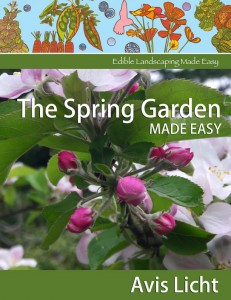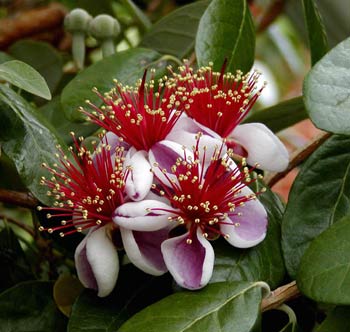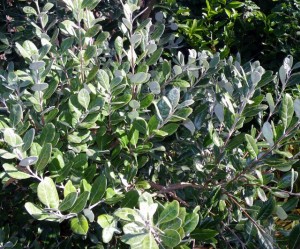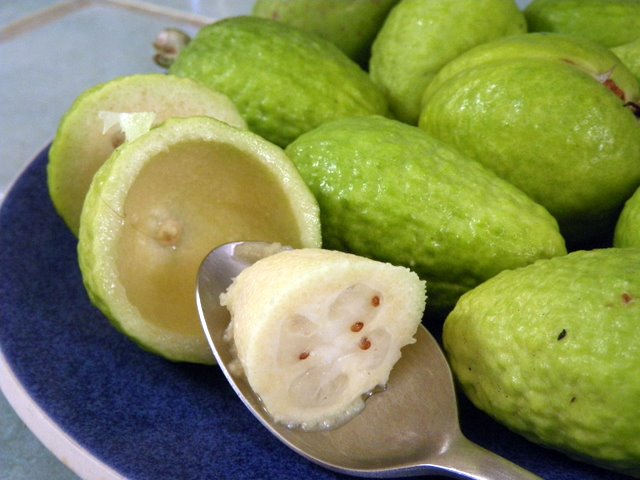by Avis Licht
The Pineapple Guava is one of my favorite plants. It serves many purposes in the edible garden. It’s an easy care, evergreen shrub that has edible flowers, edible fruits and somehow, the deer DON’T eat it. How could you know?
Where I live, deer eat almost all our plants, so having one that does all these good things is a real treasure.
Climate:The Pineapple guava grows in Zones 8 – 10. What this really means is that it likes some cool weather, can go down to 10 deg. F, likes rain in the 30″ – 40″ range, and doesn’t like super hot daytime weather – not so good in the desert.
Soil: It’s adaptable to a wide range of soils, including acidic soil, but prefers a humus rich soil that is well drained. Adding compost and not manure works for this plant.
Water: This is considered a drought tolerant plant, meaning it survives with relatively little water, but needs adequate water for good fruit production. During dry spells you should give it additional water. In real terms, this means observe your plant. In real terms, in the garden, you always need to observe your plants. Everyone’s garden is different from the norm that all these books talk about. You’ll always want and need to adjust requirements to your own situation.
If you need some great information on starting your Spring Garden, have a look at my new ebook, called The Spring Garden Made Easy.
Sun: Full sun is best – but it can tolerate partial shade
Wind:The Pineapple guava makes a good windbreak. It can take some salt air, but I wouldn’t put it on the dunes as a first line wind break.
Care: What I really love about this plant is that it needs so little care. It just grows happily on its own. You can prune it for shape or let it alone. If you prune it back hard, you will lose some fruit production.
Pests: Almost none. Well, I haven’t seen any.
Fruit and flowers: The flowers which bloom late Spring are edible. The thick petals are spicy and are eaten fresh. The petals may be plucked without interfering with fruit set. The fruit ripens in late Fall, which is a great boon, since almost everything else in the garden is gone. The fruit in the picture below, came from my garden on December 22 after many days of frost. They taste fresh and tangy. We eat them by scooping out the fruit with a spoon. Or you can cook them in puddings, pastry fillings, fritters, dumplings, fruit-sponge-cake, pies or tarts.
Be sure to check out my store for great tools and garden implements.
If you live in the right climate, I really think you ought to try growing the Pineapple Guava. It’s a giving and a forgiving plant for your edible landscape.
If you want to know a lot more about gardening I have lots of posts on my blog and a new e book called The Spring Garden Made Easy. For $4.99 it’s the deal of the century. Check it out here: https://www.ediblelandscapingmadeeasy.com/publications/.

[portfolio_slideshow id=1000].

 Follow
Follow




Are the pineapple guava trees/bushes ok for dogs? If they eat the fruit , if fallen, will they hurt the pets?
Britt Bauguss
No harm to the pets. I haven’t found that any of our pets are even interested in eating the fallen fruit. On the other hand, our kids LOVE pineapple guavas. I guess that’s the good news.
Question… I have had P. Guavas at my last three houses… Was told I needed a ‘grafted’ tree, so each time I ordered one. After a few years, I got fruits the size of avocados (due to the fact that I thinned the fruits on the branches, I think).
This year, in a new city, I wanted to order a grafted tree and the guy at Navlet’s acted like I was crazy and wanted to know what varieties I wanted, but said he did not think he could get it. I know Jeijoa sellowiana, but no idea what species I want for the graft. Do I really need a grafted plant?
Thanks
Just planted to small Pineapple Guava’s here in Las Vegas on the West getting Morning sun. How much watering and what do you suggest for fertilizing?
Hi Christine, an East facing side is good for pineapple guava in a hot climate. Morning sun is the best. Give it regular water so that the soil stays moist while it’s getting established. Compost is the best fertilizer for pineapple guava. It does not need a high nitrogen fertilizer. If the leaves start to turn yellow that might be a sign it needs more nitrogen.
Be sure to subscribe to the blog, Christine, so that you get regular garden updates.
Thanks for visiting my site, hope this helps.
I going to plant Pineapple Guava in my backyard, but the soil is somewhat poor – the landscape was completely change during the house building and what I have is the some kind or brownish substance (not original topsoil) that was on the top of sandstone.
Now is the question – should I try to replace the the soil for the tree or it would be good enough to mix some good nutrients into the existing soil?
Why aged horse manure is not desirable for this plant? Does it have to be only compost?
Thanks in advance.
Hi Andrey, First of all, thank you for buying my book. I hope you find it helpful.
As to your soil. Check the hole to make sure you have good drainage. You do this by digging a hole and then fillling it with water. It should drain overnight. If not, then your plant will drown when it rains. Once you check the drainage, it is usually better to mix new soil and compost with the existing soil. Don’t just put in new soil. Aged horse manure is probably fine. As long as it has composted for awhile and is not fresh.
Pineapple guavas like average soil, not too rich. Which is why they are good in so many places.
Good luck with your garden.
Sincerely,
Avis
New to Guava’s… Just planted 7 and one in a pot in Panama City Beach Florida. I planted them 100 yards from the beach.. But it has a decent size Dune to protect it from some salt air but I am worried… Other citrus have done OK here..
Hi Mike,
Make sure they get enough water and nutrients. sandy soil doesn’t hold a lot of moisture or food for the plants. Compost is always good for the plants and for the soil. good luck. Avis
I have two of these in my garden. They seem to be pretty slow growers but I also think I may have them in a bit too much sun for my south Georgia Garden. I have yet to see any fruit although I did have a few flowers for the first time last year. I have heard we don’t have it’s natural pollinator down here in GA?? Not sure where you are located but have you heard anything about that? Not sure what pollinates it but I suppose I could try doing it by hand.
Hi Katie, You don’t mention how old your plants are, but they can take a few years to set many fruits. Many insects and bees pollinate Pineapple Guava. To get more fruit, you can definitely pollinate by hand. Take a soft painting brush, like a water color brush and simply brush the pollen from different fruits onto each other. That’s all it takes. Check your soil moisture, to make sure it’s not sitting in water, as in bad drainage. They like good drainage and moderate amounts of water. Can’t say whether it’s too hot. It’s better not to have them up against the south wall of the house where they get a lot of hot reflected heat. Hope that helps. Good luck.
Avis
[…] plants. Meaning, if you have a small front yard, use dwarf or semi dwarf trees, or small shrubs. Fruit trees, blueberries, currants, strawberries mixed with flowering shrubs all make wonderful front yard […]
Do they need one or two trees in order to get fruits? I have 2 trees same type in my back yards. thanks
Hi Lisa, one bush is enough to get fruit. Pineapple guavas are 100 % self fruitful, but some give more fruit than others. You can increase the yield by hand pollinating them. Which is a different post. I’ll write one soonn, avis
I delight in, lead to I found exactly what I used to be having a look for.
You’ve ended my four day long hunt! God Bless you man. Have a nice day. Bye
Also visit my web blog: Truegreen
Publicity to rust junk and stains could very well be as drawing
attention as having a huge messy house. Improve some bulb garden compost or bone amount of
food for a amazing show next springs.
i need a answer about these plants i bought 2 from a nursery here in az they say they do well in the heat but the guy tells me to water every other day about 8 gallons but my leaves some green some brown falling off some dry some are moist dont want them to die
Hi Matt, It’s possible that you may have put your plant in too sunny a spot. In Arizona it would be best to put them on the East side of the house, where they get morning sun and afternoon shade. Also, be sure to water them at the base of the plant whee the roots are, not on the leaves, where they will get burnt. Also, if you water the soil nearby, but not the roots of a newly planted shrub, they won’t get enough water. Hope that helps.
Avis
Even though we are in Zone 9, I am concerned about our hotand humid summers. Would a pineapple guava tree/shrub do well with afternoon sun in Charleston, SC?
Maria,
Pineapple guavas are native to Brazil, Paraguay and Uruguay. They do well in high heat, but need 50 hours of winter chill. I think they will do fine in your climate in the afternoon sun. They may not set as much fruit as in a more northernly zone, but should do bear fruit.
Have you seen any in your neighborhood? That often tells the tale. Sometimes an unusual shrub is not seen until some else, like yourself plants it with success.
Let me know how it goes. I’d certainly give it a try.
Avis
I live in Yuba City, CA. It’s in the Sacramento Valley and gets over 100 degrees and very humid in the summer. I have 2 of these in my front yard. They have not been pruned, hence they are 15 ft. trees. We moved to this house about 18 months ago and I’ve been trying to figure out what the heck these were and finally discovered the answer today. Now that I know the fruit is edible, I’m really excited to try the fruit and perhaps make something yummy. Our lemon tree provides a lot of limoncello and lemon curd, so now it’s on to pineapple guava.
I live in Charleston also and have about 10 of these bushes next to the house and they are doing great! I actually just found out what they were 🙂 We get buckets of fruit in the fall and the birds eat a lot of the petal too…
[…] The pineapple guava plant blooms in a burst of protruding red-yellow stamens and pink-white petals. Also known as Feijoa sellowina, the plant produces tangy green guava fruits that ripen in autumn, according to Edible Landscaping Made Easy. The fruit lends itself well for use in pies, pastries and tarts. […]
I love this fruit i grew up eating it off the bushes that we had in our drive way, as a kid me and my sister ate this all the time. i just didn’t know what it was called. now that i found the name of this fruit im going grow me some.
I have what I know is a guava… and based on your photo of the flower, is probably a pineapple guava tree. Someone gave it to me, maybe 2 years ago. It is pruned as a tree with about a 3 foot trunk, about 5 feet tall overall, not including the huge pot it is in, that dries out easily. It has never set fruit…. It also seems infected with scale, so was going to get rid of it… but now your description makes it seem worth saving….
SO…. SHOULD I TRY to save it? I have a VERY SMALL GARDEN in Zone 9-10 coastal cool CA fog land… will it fruit here? Is it worth putting in the ground & taking up valuable space in my tiny yard? How large do they get? Do they taste like the pink guavas in Hawaii?
Thanks!
Well, you have some interesting questions about your Pineapple Guava. First of all, guavas take a few years before they start producing fruit, so that could be one problem. Second of all, plants in pots often don’t get enough nutrition to thrive. They have limited root space AND pots dry out fast, as you noticed. Clay pots and wooden planters dry out faster then sealed pots. Scale can be a problem. I would spray it with Safer Soap Insecticidal solution. It is completely organic and effective. As to the size of your yard: Guavas can get big and will overwhelm a small yard, but they can also be pruned. You could send me a photo of your yard and I could give you a better answer. It is a great plant, but possibly not exactly right for you. I don’t know about the pink guavas in Hawaii. Hope this helps. Let me know what you decide to do.
I have two Pineapple guava tree/bush, in Fremont, Ca. (12+ yrs), the fruit is so good and I share them with my family, chuch and co-workers, they all enjoy them as well. I cut the tip off and use a grapefruit spoon to dig out the yummy fruit!!!
Enjoy yours, when the fruit drops to the ground, it’s ready to eat. Only thing is I get home late and out looking for fruit with a flashlight everynite in the Oct.-Nov. months. Can’t wait to try the flowers. Silly me only just found out mine produced fruit this last year.
You’re right about them falling to the ground when ripe. I’ll add that to the post. When my kids were young, they happily crawled around on the ground to pick up the guavas. Now they’re grown and it’s up to me. Glad you discovered them.
Oh man, I wish we could grow pineapple guava in Missouri! Can it grow in a container?
Pineapple guavas get pretty big, but I don’t see why you couldn’t try it in a container. You can grow figs in a container with no problem. The main question is where are you going to put it in the winter? South side of a house is the best choice. Good luck. It’s always worth a try. Remember, it takes a few years for the plant to start producing, but it’s still a beautiful shrub during that time.
These grow, totally untended where I work in North Berkeley. I’m shameless about foraging them, since they fall on the ground when ripe.
It’s great you found the Pineapple Guavas What a shame for them to go to waste. I first found out about them 30 years ago when my parents grew one in their backyard. My kids would scramble around on the ground gathering them up and eating them by the dozens. They never could understand why none of their friends knew what a guava was. Merry Christmas.
1